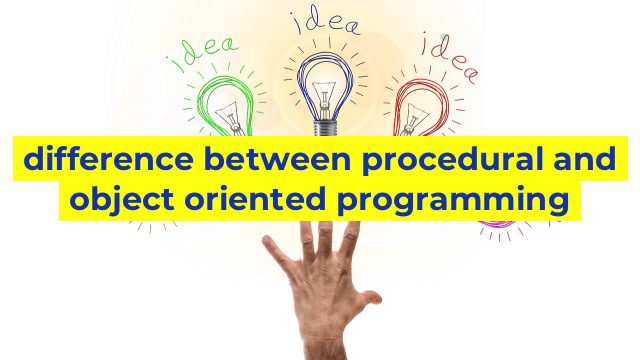The Difference Between Procedural and Object Oriented Programming
What is Procedural Programming?
Procedural programming is one of the oldest and simplest programming paradigms that is largely focused on breaking down a program into smaller modules or procedures that can be executed in sequence to achieve a specific result. A procedural program consists of a series of instructions that are executed in order, and each instruction is defined as a procedure or subprogram.
Procedural programming is typically used for small- to medium-sized projects and is often used for system programming or scientific applications. It is based on the idea of reusable code, which means that once a module or procedure is written it can be used multiple times throughout the program.
What is Object Oriented Programming?
Object-oriented programming (OOP) is a programming paradigm that is focused on creating complex and reusable code structures called objects. OOP is a more modern approach to programming than procedural programming and is widely used in software development.
In OOP, the program is divided into objects that can interact with each other. Each object represents a real-world entity, such as a car or a person, and has a set of properties and methods that define its behavior. OOP focuses on the idea of abstraction, which means that the object’s internal details are hidden from the outside world.
The Main Differences Between Procedural and Object Oriented Programming
The main difference between procedural and object-oriented programming is how they approach code organization and reuse.
Procedural programming uses procedures or subprograms that are executed in sequence to achieve a specific result. The focus is on breaking down the program into smaller modules that can be executed in sequence. The execution of the program is largely determined by the order in which the procedures are called.
Object-oriented programming, on the other hand, is focused on creating reusable code structures called objects that represent real-world entities. The focus is on the data and how it interacts with other data. The execution of the program is largely determined by the interactions between the objects.
Another difference between these two programming paradigms is the way they handle data. In procedural programming, data is usually defined globally or locally, while in OOP, data is encapsulated within objects. This means that objects have their own properties and methods, which can be used to manipulate the data they contain.
The Bottom Line
In conclusion, both procedural and object-oriented programming have their pros and cons. Procedural programming is simple and easy to learn, making it an ideal choice for small- to medium-sized projects. Object-oriented programming, on the other hand, is more complex but offers better code organization and reusability, making it an ideal choice for larger projects. Ultimately, the choice between these two programming paradigms depends on the project’s requirements and the programmer’s preference.
Table difference between procedural and object oriented programming
| Procedural Programming | Object Oriented Programming |
|---|---|
| Focuses on procedures or functions that operate on data. | Focuses on objects that contain both data and methods. |
| Variables are used to hold data. | Objects encapsulate data and methods in a single unit. |
| Functions are called to perform specific tasks. | Methods are called on objects to perform specific tasks. |
| Code is organized into procedures that are executed sequentially. | Code is organized into classes and objects that interact with each other. |
| Changes to data affect the entire program. | Data changes are contained within objects, minimizing the impact on the rest of the program. |
| Procedural programming is more suitable for small programs and scripts. | Object oriented programming is more suitable for large, complex programs. |


